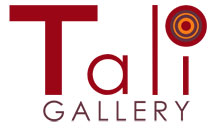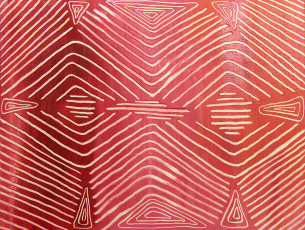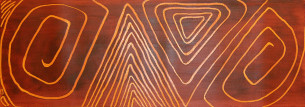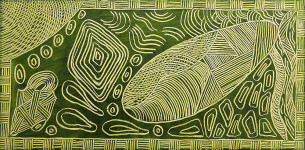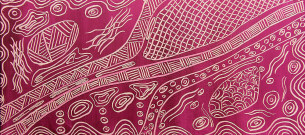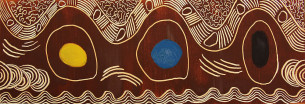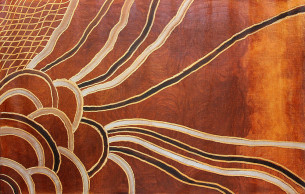These paintings are by Mary Kennedy and other artists from Ngemba Wailwan Community in Warren, NSW.
They are inspired by their forebears’ practice of tree carving and use a reflective technique of applying oil paint thickly to the canvas and then carving it out in traditional patterning.
They are beautiful in their own right, but the background story about tree carving is fascinating.
There are two types of trees that have been cut by Aboriginal People – the remaining trees are protected by state or territory law but are vulnerable to bush fires and vandalism. Â They are usually over 200 years old and are generally an oval shape with pointed ends, with the shape covered in regrowth and axe marks at the base.
Scarred trees were used to create tools for everyday life such as coolamons and canoes. Â Box and Red Gum occurring along major rivers, around lakes and on flood plains were most commonly used, as well as mature native trees at significant (sacred) sites. Â Large pieces of bark were removed and used for traditional purposes. Â There is one remaining in a public park in Parramatta but it is a rare survivor. More than 7,500 have been recorded in NSW but there are less than 100 remaining in their original location as the otheres have been removed for farming, forestry or development. Â There is also a very large scarred tree site with aobut 900 red gums and black box trees scarred by the Dja Dja Wurrung people to be found north west of Melbourne in Victoria – more than 600 stone tools and weapons and about 500 cooking mounds were also found nearby.
“(Scarred trees) are our history books, but are also a manual for sustainable use of resources suited to the present day.” Â Stuart McFarlane, Manager RMIT Ngarara Willim Indigenous Centre, Melbourne.
Carved trees were used as markers and warning signs for sites of special significance such as initiation or burial sites. Â They are a form of visual communication. Â Tree carings can be found dotted throughout Australia but are mainly the work of Gamilaroi and Wiradjuri artists from NSW. Â They are also known by other names such as arboglyphs, dendroglyphs and teleteglyphs. Â When used to mark a burial site, the carving on the tree usually faced the grave of an important man and the design reflected the cultural heroes of this man and provided a pathway for his spirit to return to the sky world. Â There were several different types of carvings – figurative images were rare while curvilinear lines were most frequent. Â Chevrons or V shaped designs and scrolls or circles were also evident.
“Carved tree designs) represent a people’s oul – they are the embodiment of an actual people’s culture and history.” Â Djon Mundine, arts curator.
A few white settlers became passionate about documenting and collecting relics, including carved trees. Â A book was written by Robert Etheridge in 1918 as an attempt to catalogue the estimated 600 Aboriginal tree carvings in NSW. Â “Burial Trees” Â by Lindsay Black, was published in 1941 and was the first book to focus on Wiradjuri tree carvings. Â “The bora Ground” in 1944 catalogued Gamilaroi carved trees. Â Interest was also shown by Edmund Milne and Clifton Cappie Towle.
Some trees were cut during the 1900s and their carved sections were sent to Australian Museums. Â Today, these are being returned to their respective Aboriginal communities to aid healing processes. Â The Museum of Victoria returned a section of a carved tree to the Local Aboriginal Land Council in Baradine, 490km north west of Sydney after two years of campaigning. Â It had originally been cut by rangers in 1918 and sent to the Australian Museum in Sydney but was then transferred.
An Aboriginal artist, Elder Vic Simms carved a tree in the Botanic Gardens in Sydney in 2011. Â He is one of several artists from all over NSW Â looking at carved trees as inspiration or to revive the practice. Digby Moran (Bundjalung Artist from Northern NSW) has been told by the Australian Museum that his great grandfather carved a tree currently held there and have commissioned him to paint 45 acrylic paintings using symbolism based on the tree carving design. Â He was also told that his forebear would have stood on the shoulders of a man who would have been standing on the shoulders of another man while carving the tree. Â Most of the carved trees in public collections are not on display because of their age and fragility, being more than 100 years old. Â Community consultation would also need to be carried out to gain approval.
You can see examples of carved trees in photographs and learn more about them on this State Library of NSWÂ http://www.sl.nsw.gov.au/events/exhibitions/2011/carved_trees/
